If you have a young school-aged child, I’m sure you have seen (and used) the lined handwriting paper. While this paper is great for primary-aged writers, most preschoolers do not posses the fine motor skills to write on the small lined paper. But one thing is for sure: most preschoolers are more than ready to be exposed to handwriting in meaningful ways. How exactly do you teach handwriting to preschoolers? Today I’m sharing 5 effective ways (with loads of free resources) to help teach handwriting to preschoolers.
*This post contains affiliate links. Please read my full disclosure policy for more information.
1. Strengthen Fine Motor Muscles
Most young children need to strengthen the muscles most used for pencil grip and writing (we call this fine motor work). Fine motor work at this age can and should be super fun. Our preschoolers shouldn’t even suspect our motive. Here are a few ideas for doing just that:
- Play with playdough! My kids love our open-ended playdough mats. They also enjoy adding things to the playdough like we did with our turkeys and snowmen.
- Integrate toys that strengthen fine motor muscles such as Legos, Mr. Potato Head, stacking pegs, Cootie, or Bristle blocks (now called Stackadoos).
- Use clothes pins. My kids love to play with these! We’ve used them to paint as well as count and clip syllable activities.
- Lacing cards or lacing beads. {Most of my FREE updated and expanded Pre-K/K packs have lacing cards to match each theme.}
- Scissor fun. Hands-down my favorite scissors for beginners are the Maped Koopy Spring Scissors. Both my preschoolers have them. I have several themed Cut it Out! packs for young children learning to cut…with more on the way!
- Tweezers or scoops. Catch bugs outside with them. Incorporate them into play. Transfer objects from one bowl into fun ice trays. There’s so much you can do with tweezers, tongs and scoops!
- Pom-poms or other small manipulatives.
- 5 Writing Grasp Strengthening Activities {Cheerios and Lattes}
- You can find more ideas in my Gift Guide for Pre-Readers and Pre-Writers.
2. Start with Bigger Spaces
For young children, think big, open spaces for writing. Most young children simply aren’t ready for that lined paper, even if the lines are bigger. It can actually be a barrier. Here are a few great ideas that can help you to think big:
- Write on the mirror {from Coffee Cups and Crayons}
- Head to Toe writing {from Playdough to Plato}
- Sidewalk Chalk writing {from In Lieu of Preschool}
- Dry erase boards- Magnetic dry erase boards are great because you can use them with magnetic letters. I also bought shower board from my local hardware store and had them cut the pieces in large pieces so that my preschoolers had a lot of space to write. Shower board is inexpensive and works GREAT as a dry erase board.
- Easel writing (love my IKEA easel)
- Older preschoolers may even be ready for the paper, but keep it big. The Measured Mom has some great handwriting sheets specifically designed for older preschoolers for upper case and lower case. Carisa at 1+1+1=1 also has some fabulous handwriting pages in her RRSP printables.
3. Teach Handwriting with Different Mediums
Besides big open spaces, it’s just fun to write in lots of different ways and with many different mediums. For example,
- Write in the air- Just recently MBug (age 3.5) air “traced” names of the people in our family. I wrote down the words on our dry erase board and she “traced” them. This idea is perfect for children who are perfectionists because while they are practicing letter formation, they are not actually producing a written product. In other words, they can’t see the results if they “mess up”.
- Write on chalkboards {Creekside Learning}
- Write with Q-tips {Lesson Learnt Journal}
- Write with ice {Cultivated Lives}
- Bathtub writing play {Parent Teach Play}
- Write in Salt {Teach Preschool}
- Poke Page with letters, numbers, shapes or even words- SUPER easy! You can find a poke page for basic sight words in every lesson of Reading the Alphabet and fine motor variations of the poke page at The Homeschool Classroom.
- Pre-writing tracing pages {3 Dinosaurs}
- Write with bathtub crayons (some of my kids’ first letters were written in the bathtub!)
- Set up stations and feature a lot at once- I just love The Measured Mom’s stations she set up at her kitchen table. There are so many different mediums used to form those letters. What fun!
- Melissa at Imagination Soup also shares some great tips on teaching handwriting in developmentally appropriate ways.
4. Expose them to Letter Play
A big hurdle in learning to write is remembering what the letter looks like in the first place! We need to expose them to the letters themselves in meaningful and playful ways, such as:
- 26 Ways to Learn the ABC’s (from A to Z}
- Visualizing Letters {fun game for thinking about what letters look like}
- Finger Tracing Letters {The Good Long Road}
- Sensory Letters {Learn Play Imagine}
- Use Foam Letters
- Cork Board Letters {No Time for Flash Cards}
5. Encourage Correct Pencil Grip
Some young children get it the first time they hold a writing utensil. That was both of my girls at age two. Both of my boys were more around age four when it happened for them. For those who take a little longer, a little encouragement through play and picking certain writing utensils can help to push them along. I am well aware that no matter how much you encourage some children, they are not ready (or have no desire) to hold the pencil with the tripod grip. Even though you will still want to encourage them, remember that at a young age, writing should be about exploring and having fun, not forcing our kids to hold the pencil correctly. Here are some of my favorite resources for encouraging correct pencil grip:
- Pip Squeak skinny markers– These markers are skinny and make it easier for kids to hold the marker correctly, instead of fatter markers that encourage more of a fisted grip (using the entire hand to grip the marker.) The same is true of the fat crayons versus the skinny crayons.
- Break crayons in half. Yes, you heard me. Do it! 😉 Shorter crayons also encourage that tripod grip.
- Magna Doodle– ALL of my children enjoyed the Magna Doodle as toddlers as so far as preschoolers, too! I love how the pen included is skinny as well as the shapes to encourage correct grip.
- Painting with thin paint brushes
- More Tips for Correct Pencil Grip
- Proper Pencil Grasp Development for Handwriting {Golden Reflections}
Above all, let handwriting be fun and meaningful! Sneak writing into play and sneak play into writing!
~Becky
Find MORE Handwriting, ABC, Fine Motor, and Preschool ideas on my Pinterest boards:
Follow This Reading Mama’s board Handwriting on Pinterest.
Follow This Reading Mama’s board ABC Goodies on Pinterest.
Follow This Reading Mama’s board Fine Motor on Pinterest.
Follow This Reading Mama’s board Preschool Learning on Pinterest.
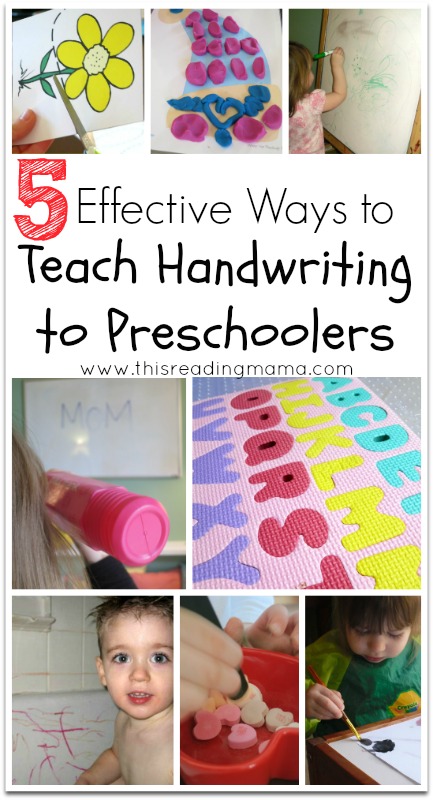
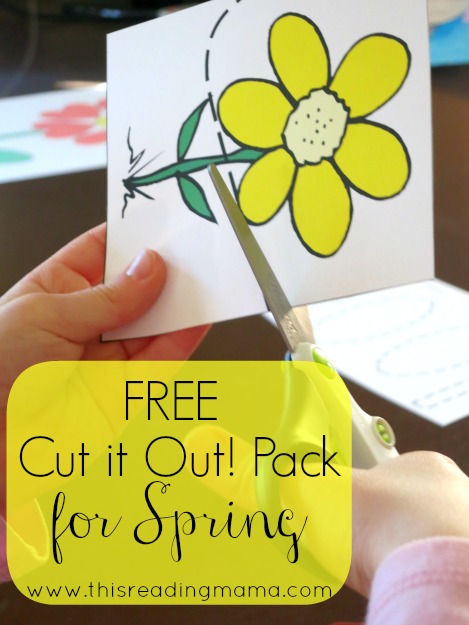
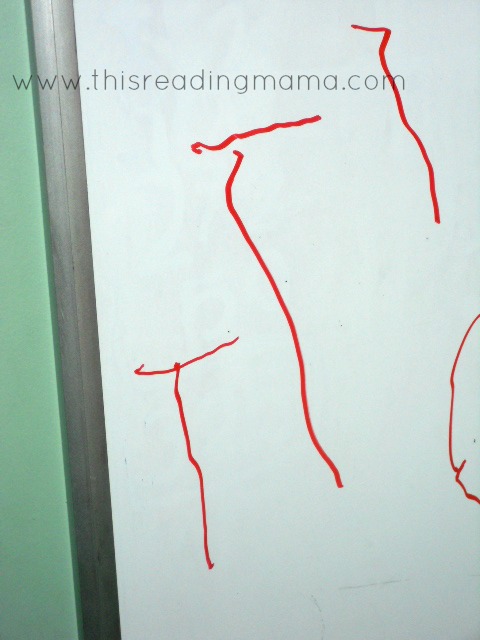
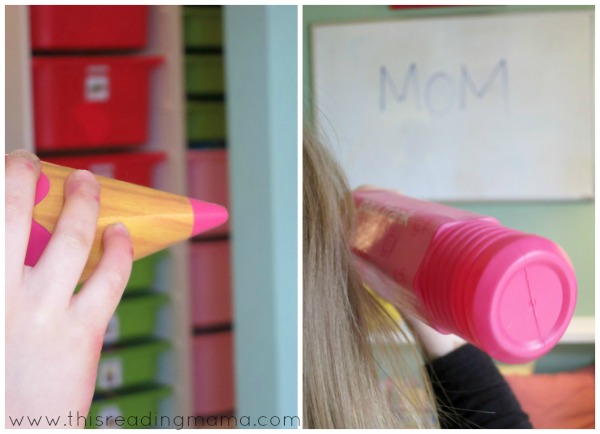

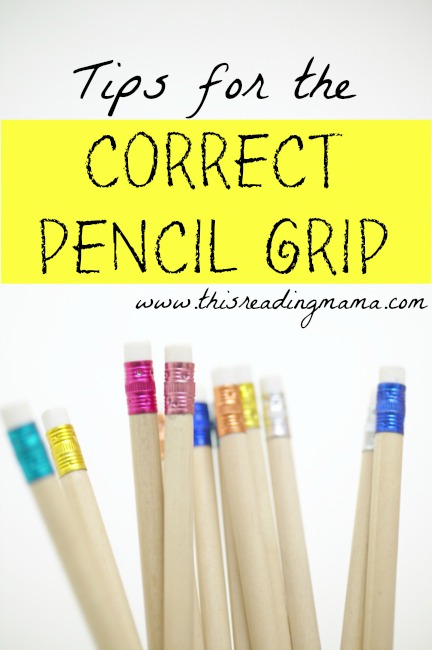
Thanks for including my proper development of hand grasp post! This is an awesome resource, pinning now! 🙂
You’re very welcome! Thanks for pinning. 🙂
Great advice. This is something we are working on with our son. Thanks for the ideas.
You’re very welcome, Jodie! Thanks for stopping by. 🙂
Awesome ideas! Thanks for sharing!
Heidi Butkus
You’re very welcome!
Thanks Becky for such meaningful post.I did big mistakes with my elder one, but now I’ll pay heed all the points you mentioned.
One big problem with my kids is they simply avoid writing though I try to include as much fun as possible.